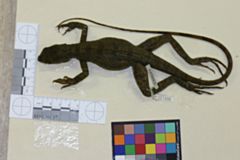Project 2602: G. W. Taylor, J. C. Santos, B. J. Perrault, M. Morando, C. R. Vásquez Almazán, J. W. Sites. 2017. Sexual dimorphism, phenotypic integration, and the evolution of head structure in casque-headed lizards. Ecology and Evolution. 7 (21):8989-8998.
Abstract
Sexes can differ in features associated with differential reproduction, which can be used during courtship or aggressive encounters. Some traits tend to evolve independently between sexes and emerge as sexually dimorphic within the organismal phenotype. We characterize such a relationship by estimating the phenotypic integration of the head morphology and modularity of the crest in the casque‐headed lizards (Corytophanidae). In this clade, some species show extreme sexual dimorphism (e.g., head crests in the genus Basiliscus) while in others, both sexes are monomorphic. To characterize these patterns, we define phenotypic integration at the interspecific level as a pattern or network of traits evidenced by phylogenetically adjusted correlations that persist among species. At this level, modularity is an increased connectedness (e.g., higher correlation) among sections of these networks that persist in a lineage during the evolution of complex phenotypes. To test both concepts, we used phylogenetic geomorphometrics to characterize the head structure of corytophanid lizards, based on a time‐calibrated phylogeny that includes candidate fossil ancestors. We found evidence of an older diversification of corytophanids than previously reported (~67 vs. ~23.5 MYA) and show that this clade includes two morphological head architectures: (1) Sexually dimorphic crests present in males that are evolving independently from the rest of the head structure, and (2) full integration of the head morphology in monomorphic species. We propose that both architectures are optimal evolutionary trajectories of the parietal crest bones in the head of these lizards. In sexually dimorphic species, these bones are elongated and thinner, and gave rise to the extended crest used in male courtship displays. In monomorphic species, the parietal crest grew thicker in both sexes to allow for a better insertion of muscles associated with a stronger bite.Read the article »
Article DOI: 10.1002/ece3.3356
Project DOI: 10.7934/P2602, http://dx.doi.org/10.7934/P2602
| This project contains |
|---|
Download Project SDD File |
Currently Viewing:
MorphoBank Project 2602
MorphoBank Project 2602
- Creation Date:
26 January 2017 - Publication Date:
07 February 2020
This research
supported by
Authors' Institutions ![]()
- Museo de Historia Natural de la Universidad de San Carlos de Guatemala
- Brigham Young University
- St. John's University
- Consejo Nacional de Investigaciones Científicas y Técnicas (CONICET)

